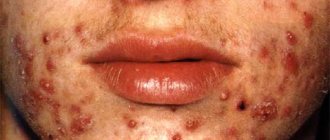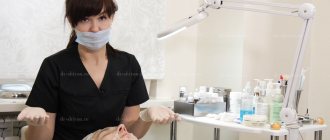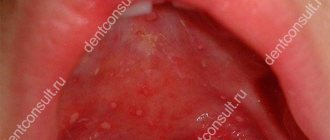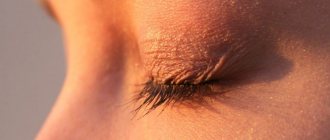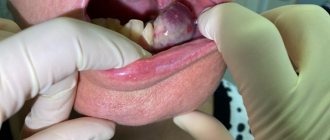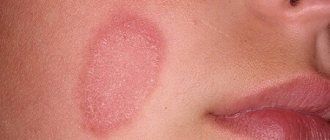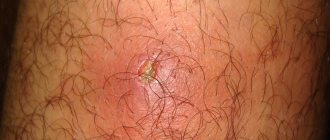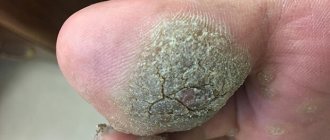| Some women experience increased facial hair growth. Some of them have hair visible above the lip, others even on the chin, like a beard on men. In medicine, excess male pattern hair growth in women is called “hirsutism.” This is explained by the large amount of male sex hormones in the female body. |
- Briefly about hirsutism
- Androgen hormones
- Symptoms
- Causes
- Forms of the disease
- Diagnostics
- Treatment
- Forecast
Briefly about hirsutism
Women with hirsutism have psychological problems because this appearance, to put it mildly, is not popular with anyone.
Everyone laughs at women of this type. Hair that grows in the wrong places is called terminal hair. They are located on the stomach, back, chest, and also, as mentioned above, above the upper lip and on the chin. With hirsutism, women's hair is coarse, long, and dark in color. Each hair contains a shaft. Their bulbs are not the same as vellus hair, which normally covers part of a woman’s body (and even her face, if you look closely).
Every twentieth woman of reproductive age suffers from excess facial hair. And in menopausal age, hirsutism is diagnosed in every fourth person. Some women with hirsutism have problems with the menstrual cycle and therefore cannot conceive a child for a long time. They also experience depression.
Procedures for hirsutism in women
- Shaving, bleaching, waxing. Many cosmetologists and doctors believe that in case of hirsutism, these procedures are strictly prohibited, since women's skin is very delicate, and such manipulations cause irritation, redness and inflammation, and this, in turn, provokes the appearance of even more hairs, as well as their ingrowth.
- Depilatory creams are an acceptable method as they do not cause the above symptoms.
- Laser hair removal and photoepilation are considered the most effective and harmless method, since they stop hair growth and do not cause inflammation or ingrown hairs.
The prognosis for hirsutism is not the most favorable; it is not possible to completely get rid of the disease. However, the patient can stop hair growth, thereby significantly improving her quality of life!
Related articles: Laser hair removal - contraindications
Androgen hormones
Androgens are divided into several types, among which testosterone is the most common. A large amount of it is usually found in men. It is needed there for the formation of ejaculate and secondary sexual characteristics, that is, hair on the legs, chest, rough voice, etc.
Healthy girls should have testosterone in very small quantities. Normally, it should not cause disturbances in the cycle, libido and the ability to conceive and bear a child. If a woman’s level of the hormone testosterone increases, then male-type changes begin inside and outside her.
Also among the androgens are androstenedione and dehydroepiandrosterone. They become testosterone in the future.
Symptoms
The main manifestations of hirsutism:
- hair on the face of women, as well as on the inner thighs, butt, abdominal area, back, chest, around the nipples
- active hair loss on the head, mainly in the frontal area
- oily skin and oily hair
- amenorrhea or menstrual irregularities
- acne
- infertility (a woman is not protected, but this does not lead to conception)
If the situation with hormonal imbalance is not corrected, then in the future the so-called virilization will begin, which is manifested by the following symptoms:
- baldness at the temples
- rough voice
- reduction of glandular tissue of the mammary glands (breasts become smaller)
- redistribution of fat according to the male type (fat mass accumulates not on the hips or butt, but on the arms, shoulders, chest)
- increase in muscle mass, especially in the shoulder area
- increased sexual desire
- reduction in the size of the labia
- clitoral fascination in size
- decreased amount of vaginal lubrication
Causes
Many people are interested in the question of why facial hair grows on women. The essence of the process is that vellus hair (which by nature has no color and is very thin, almost imperceptible) becomes terminal, that is, long, hard and dark. In 90 out of 100 cases, the cause of hirsutism is polycystic ovary syndrome.
The balance of male and female sex hormones changes during menopause and during pregnancy. A large amount of male sex hormones in women is called hyperandrogenism. The reason may be:
- polycystic ovary syndrome
- hypothalamic type amenorrhea
- permanent anovulation
- ovarian hyperticosis
- neoplasms in the ovaries
- entering menopause, when testosterone levels naturally rise
Increased sensitivity to androgens
In ¼ of cases, there is no increased level of androgens during hair growth. But there is a very strong sensitivity to them, which leads to hirsutism. Doctors note in such cases that the balance of hormones is healthy, but the body reacts more strongly than necessary to male hormones.
Adrenal gland disorders
Adrenal gland function may be abnormal due to adrenal hyperplasia (may be primary or secondary), as well as due to tumor formations in the organ. Excessive amounts of steroid hormones, including androgens, are produced.
Pituitary gland dysfunction
This reason is noted for these diagnoses:
- pituitary prolactinoma
- Itsenko-Cushing syndrome
- acromegaly
When the pituitary gland is damaged first, the adrenal glands are also affected. They begin to produce extra doses of cortisol and androgens.
Hereditary causes
This is called familial hirsutism. In some nations and some families, for many generations, girls are born with too much hair on their bodies. These chromosomal and genetic factors affect the individual characteristics common to a certain genus.
Taking medications
Facial hair in women can result from taking the following medications:
- anabolic steroids, including Clomid
- corticosteroids, including hydrocortisone and betamethasone
- progestins, e.g. Orvette
- androgens, including andriol
- antibiotic "Streptomycin"
- immunosuppressants, including sandimmune
Uncertain reason
If doctors cannot identify the cause of hirsutism, they talk about the idiopathic form of the pathology. Patients develop increased sensitivity of skin receptors and hair follicles to androgen hormones. The symptoms are erased, and the balance of hormones is almost normal. A woman can give birth to children.
How to treat excessive hairiness in a girl
There are several treatments for hypertrichosis in women. Let's look at medical treatments and methods that help hide hairiness in girls.
Treatment
The key to effective treatment is sufficient diagnosis, as a result of which the cause of the development of the disease was determined. Depending on what caused it and the individual characteristics of the person, treatment is prescribed:
- hormone therapy (oral contraceptives);
- Often, losing excess weight helps bring hormones back to normal without taking additional medications;
- the use of drugs that block androgens (male sex hormones).
It is worth remembering that bringing hormonal levels back to normal takes several months or more; this is a long process that requires constant compliance with the doctor’s instructions.
If hypertrichosis is caused by neoplasms or physiological characteristics of certain organs, then surgical intervention may be prescribed.
Forms of the disease
Forms of hirsutism are distinguished according to the reasons that provoke the pathology:
- dermatological (familial and idiopathic)
- exogenous (disease provoked by the drugs listed above)
- neuroendocrine (pituitary, ovarian, adrenal)
There is another division, which is based on the presence of violations:
- without accompanying disorders
- with ovulation disorders;
- with piloseborrheic complex of increased activity (acne and blackheads)
- with signs of virilization
Diagnostics
The doctor collects anamnesis by asking the patient and her family a series of questions. Laboratory tests are also ordered. A woman should see an endocrinologist and an experienced gynecologist. If total testosterone is less than 200 ng%, and decreases when taking oral contraceptive pills, then the woman is considered to have polycystic disease. If WC is more than 200 ng%, then it is assumed that there is a tumor in the ovary.
Dehydroepiandrosterone sulfate is also determined in laboratory tests. If it is more than 700 ng% and decreases when taking dexamethasone, the patient is suspected of having adrenal hyperplasia. If the level is above 700 ng% and does not decrease, then the cause of hirsutism is an adrenal tumor.
Cortisol levels are high in Cushing's syndrome. If a high level of androstenedione is detected, then the cause of increased hair growth in a woman should be sought in the ovaries. In polycystic disease, the level of luteonizing hormones is higher than follicle-stimulating hormones. The level of 17-hydroxyprogesterone is higher than normal if the patient has a congenital form of adrenal hyperplasia.
Instrumental studies if a woman has facial hair:
- ultrasound diagnostics of ovaries and adrenal glands
- computed tomography and MRI of the brain and adrenal glands
- diagnostic laparoscopy of the ovaries (if it is suspected that the cause of hirsutism is in tumors)
Consequences
Increased hairiness in our time causes serious emotional discomfort to women and forces them to undergo many cosmetic procedures. If you don’t notice the problem for a long time and don’t look for a solution, you can seriously neglect your health, which will lead to the following consequences:
- baldness;
- development of female infertility of various nature;
- endometrial hyperplasia;
- insulin resistance;
- diabetes;
- hyperlipoproteinemia.
Treatment
If a woman’s facial hair is slightly higher than normal, and her menstrual cycle is stable, then she is not prescribed treatment. Hirsutism is not a separate disease. This is only a symptom indicating certain disorders in the body. That is, treatment should be carried out taking into account the cause. If there is a formation in the patient’s pituitary gland, it must be removed surgically. It may also be necessary to remove a tumor of the ovaries or adrenal glands, if any are found.
If the form of the pathology is medicinal, then discontinuation of the drug is necessary. You need to contact the doctor who prescribed it to you and explain the situation. He should prescribe another drug that will not cause increased hair growth on the face and other places.
Drug treatment is carried out only if a tumor that produces androgens is not detected. The doctor prescribes 3-6 month courses of treatment with hormone-based drugs. Sometimes patients need to repeat the course of treatment. But under no circumstances should you diagnose hirsutism for yourself and begin treatment at your own discretion! Any changes in hormonal levels can cause serious problems, even fatal cancer.
Treatment of hirsutism with hormones prevents new hair from growing. But those that are available will not fall out. You will have to get rid of them in another way.
When the amount of androgens in the body is increased, medications are prescribed that lower the level of testosterone in the female body and also reduce sensitivity to this hormone. This is Yarina, Zhanine or Diane-35. Congenital adrenal hyperplasia is treated with drugs such as Cortisol and Prednisolone.
For polycystic ovaries, the doctor prescribes Clomiphene and hormonal contraceptives for therapeutic purposes. If formations are found in the adrenal glands, ovaries or pituitary gland, surgery must be performed. Chemotherapy may be prescribed.
Hormones should not be used to treat patients who have:
- individual intolerance to a certain hormone
- tumors in any organs
- breastfeeding baby
- pregnancy
Psychological treatment
Increased facial hair growth may also lead to excess weight gain. Then doctors recommend a special diet with a low carbohydrate content. Sometimes they resort to the help of a psychologist if depressive moods or psychosis are present. The decision on such treatment is made by the attending physician, taking into account the individual characteristics of the patient’s situation.
Cosmetological treatment
Women with hirsutism are interested in the question of how to remove facial hair. There are cosmetic procedures for this. But they will not help stop hair growth, but will only remove or discolor the existing “antennae”. Therefore, you cannot refuse other treatment suggested by your doctor.
Hair is lightened by specialists using hydroperite, hydrogen peroxide or newer developments. The natural pigment is removed from the hair, and it is less noticeable. But this is true if there is not much excess hair.
Plucking is also important. Specialists use tweezers to remove hair. And then the skin needs to be treated with antiseptic agents. If you pluck your own facial hair with tweezers several times a week, your skin will become rough and your hair will grow more noticeable and longer. You also risk not treating your skin enough with alcohol and causing an infection.
Waxing, sugaring or shaving are relevant if you want to get rid of hair on your legs, stomach, or back. If terminal hair grows again, then there is no need to abuse this procedure. Scar tissue may grow in place of the removed hair.
Photoepilation and laser hair removal are considered less cost-effective procedures. In the first method, the hair is exposed to targeted flashes of high-pulse light. The follicle from which the hair grows is destroyed. The method is relevant if you have dark hair. The effect lasts for approximately 5 months.
Laser hair removal uses special equipment that emits a beam that passes through the hair. Cells with melanin heat up, the follicle is destroyed. Dormant bulbs do not die in this case, so hair can grow again in the cleaned areas. You will need to undergo at least 3 laser hair removal sessions to completely cleanse a certain area of the skin of hair.
Contraindications to the described hair removal methods:
- inflammation in the area where you plan to get rid of hair
- tattoos
- bearing a child
- solarium or tanning at sea
- porphyria
- Availability
- insulin pump
- pacemaker
- taking isotretinoin or steroids
Traditional treatment
Since hirsutism is associated with internal changes, it makes sense to treat them so that the hair disappears. Traditional medicine can be used as a cosmetic product.
- Unripe walnut juice
You need to take a green nut, cut it in half and squeeze out the juice. There will be a tiny amount of it. This juice should be used to lubricate the roots of the hair that is bothering you. Repeat the procedure 3-4 times (but with breaks).
- Garlic
Take fresh garlic and turn it into a crushed state (mush). Apply this paste to the hair roots for ten minutes. If you apply this product to a certain area several times a day, hair will grow less actively there.
- Datura decoction
Take the leaves and stems, chop them, add water (so that it covers them), cook over low heat for an hour. You will receive a medicinal decoction that needs to be cooled. Then lubricate the hair roots with it, repeat the procedure twice a week. Remember that the plant is poisonous. Therefore, it should not get into your mouth, eyes, etc.
Diagnosis of increased hairiness in a girl
If you have a problem and want to fix it, the first step is to contact a specialist. The following specialists deal with this problem: endocrinologist, gynecologist, dermatologist. A specialist will study your problem and, if necessary, tell you what tests to take and what procedures to carry out.
The doctor examines the patient’s medical history and is also interested in the following questions:
- what medications the patient takes, for how long, for what purpose;
- whether there is a menstrual irregularity;
- whether there are relatives with similar symptoms.
The doctor also prescribes the necessary laboratory blood tests: for certain hormones, as well as biochemical and general blood tests.
If necessary, the following studies are carried out to clarify the picture:
- Ultrasound of the pelvic organs;
- It is possible to conduct an MRI or CT scan of the adrenal glands, pituitary gland, hypothalamus.
